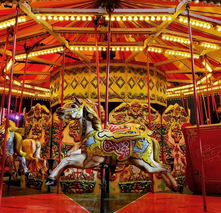



CAROUSEL HIRE
The Carousel is the perfect ride to hire for Weddings, Private Parties, Corporate Events and Festivals. It is a ride that can hold large amounts of guests in one go, making it a great addition for larger events too! Not only is the classic carousel a stunning traditional ride, it is a ride the whole family can enjoy! Our victorian carousels are lovingly restored and hand painted to ensure they look pristine for your event. Carousels also make for the perfect photo opportunities and therefore if you are looking for an instagrammable moment, look no further!

Set Up Time - 6 - 8 hours
De- Rig Time - 3 hours
Size Required - Approx 50ft x 50ft
Power - Power is supplied by us using one of our generators
Music - All carousels come with original fairground Carousel music however this can be turned off if requested.
Access - The entrance required for the carousel is a minimum of 9ft. There needs to be good access once the Carousel is through due to it being trailer mounted and needing good space to manoeuvre.
Trackway - Trackway can be supplied if the ground is soft at an additional cost.

The Carousel is operated by staff provided by us. This gives you peace of mind when hiring a Carousel for your event. The operator will ensure everyone is on the ride safely and will manually operate the ride controlling the speed and duration.
Operating
How much will it cost?

How much will it cost? When it comes to the cost, the prices can really vary. Google has made it very easy to find what you are looking for but you can't always guarantee the quality. We are not the cheapest on the market but what we can guarantee is ride quality, reliability of the team and safety! We believe these are points that you can not compromise on! Our average Carousel Hire ranges from £3000 - £3500 for a standard 6 hour operation. A more complex set up will be a higher fee.

All of our rides come fully insured and documents are available on request. The Carousel will come with an ADips certificate, Public Liability Insurance, a Risk Assessment and Method Statement.
Insurance
HISTORY OF THE CAROUSEL
A carousel (American English: from French carrousel and Italian carosello), roundabout (British English),[1] hurdy-gurdy (Australian English, esp. SA),[2] or merry-go-round, is a type of amusement ride consisting of a rotating circular platform with seats for riders. The "seats" are traditionally in the form of rows of wooden horses or other animals mounted on posts, many of which are moved up and down by gears to simulate galloping, to the accompaniment of looped circus music.[citation needed] This leads to one of the alternative American names, the galloper. Other popular names are jumper, horseabout, horse tornado and flying horses.
Carousels are commonly populated with horses, each horse weighing roughly 100lbs (45 kg), but may include a variety of mounts, for example pigs, zebras, tigers, or mythological creatures such as dragons or unicorns. Sometimes, chair-like or bench-like seats are used, and occasionally mounts can be shaped like aeroplanes or cars.
The modern carousel emerged from early jousting traditions in Europe and the Middle East. Knights would gallop in a circle while tossing balls from one to another; an activity that required great skill and horsemanship.[citation needed] This game was introduced to Europe at the time of the Crusades from earlier Byzantine and Arab traditions. The word carousel originated from the Italian Carosella and Spanish Carosella ("little battle", used by crusaders to describe a combat preparation exercise and game played by Turkish and Arabian horsemen in the 12th century). This early device was essentially a cavalry training mechanism; it prepared and strengthened the riders for actual combat as they wielded their swords at the mock enemies.
By the 17th century, the balls had been dispensed with, and instead, the riders had to spear small rings that were hanging from poles overhead and rip them off. Cavalry spectacles that replaced medieval jousting, such as the ring-tilt, were popular in Italy and France. The game began to be played by commoners, and carousels soon sprung up at fairgrounds across Europe. At the Place du Carrousel in Paris, an early make believe carousel was set up with wooden horses for the children.
By the early 18th century carousels were being built and operated at various fairs and gatherings in central Europe and England. Animals and mechanisms would be crafted during the winter months and the family and workers would go touring in their wagon train through the region, operating their large menagerie carousel at various venues. Makers included Heyn in Germany and Bayol in France. These early carousels had no platforms; the animals would hang from chains and fly out from the centrifugal force of the spinning mechanism. They were often powered by animals walking in a circle or people pulling a rope or cranking.
By 1803 John Joseph Merlin had a carousel in his Mechanical Museum in London, where gentry and nobility liked to gather on winter evenings. The horses "floated free over a pole". It was connected to a "big musical instrument that played a fully orchestrated concerto" and from the first note, the carousel would start turning while each horse would make a galloping movement with a visitor riding on its back. Merlin did not patent his inventions and engineers were allowed to come to create their own models of his creations.
For more information please visit Wikipedia







